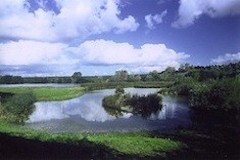Lackford Lakes
Created from former gravel pits, the Lackford Lakes are now part of a diverse nature reserve with meadows, woodland, reed beds and streams. CEMEX UK worked with the Suffolk Wildlife Trust for many years to rehabilitate this quarry, creating new breeding and hunting grounds for a variety of birds and other wildlife. We donated the site to the Wildlife Trust in 2000.



The diverse habitats and species of the Lackford Lakes Nature Reserve
Rare species found at the Lackford Lakes Nature Reserve:
- Kingfisher
- Otter
- Hobby falcon
- 17 species of dragonfly and damselfly
CEMEX relies on raw materials such as limestone, sand, gravel and clay to make its cement and concrete products. These are essential for building the roads, schools and homes that society needs, but quarrying the materials has the potential to degrade habitats and damage species unless the land is carefully managed. We are determined to have a positive impact on nature by promoting a diverse range of habitats and species while quarries are active, and by rehabilitating disused sites. By restoring former quarry sites we also provide communities with new nature reserves and education and leisure facilities.
Lackford Lakes Nature Reserve is a former quarry that provided 3.5 million tonnes of sand and gravel between 1968 and 2000. From the mid 1980s CEMEX worked with the Suffolk Wildlife Trust to gradually rehabilitate the site and turn parts of it into a nature reserve. The reserve was designated as a Site of Special Scientific Interest (SSSI) in 1997 for its wildfowl and dragonfly populations and received the first Chairman's Award from the Quarry Products Association in 2005. When the last quarry closed in 2000, CEMEX UK donated the entire site to Suffolk Wildlife Trust, who continued to restore the land. With its network of hides and footpaths, the 128-hectare reserve offers visitors superb opportunities to observe and enjoy wildlife throughout the year.
As quarrying slowed down at Lackford in the 1980s, CEMEX UK partnered with the Suffolk Wildlife Trust to begin rehabilitation works. Over the years, the reserve has been gradually expanded and today forms a 128 hectare mosaic of lakes, pools, woodland and grassland that provide a home to a variety of birds and other wildlife. The Trust designed the reserve so the local community could take full advantage of the natural beauty and educational opportunities Lackford Lakes has to offer. There is a network of hides and footpaths and a free visitor centre providing trail maps and educational leaflets. In addition, the Trust organises youth programs and educational courses throughout the year.
After years of restoration, CEMEX UK and the Trust have turned an extensive gravel quarry into a diverse lake ecosystem that provides a safe haven for many species, including some that are endangered. The site attracts large numbers of migratory birds such as nightingales, starlings and ospreys that nest among the reed beds along the lake shores. Every year, as many as 28,000 winter gulls roost at the site, providing a spectacle that attracts many visitors to the reserve. The site has become one of the best places in Suffolk to spot kingfishers, and cormorants are often seen fishing in the lakes or roosting in the tall trees by the river.
With help from experts at the Royal Society for the Protection of Birds (RSPB), we have developed an ambitious ten-year biodiversity strategy. This sets challenging targets, including our goal to create and maintain, by 2020, 1,000 hectares of habitats identified by the UK Government as conservation priorities.
For more information please contact us.
